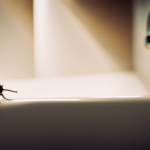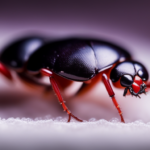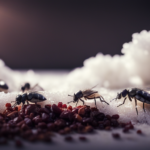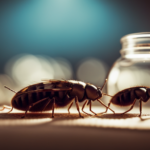Beginners Guides
What Are These Tiny Grey Bugs In My House
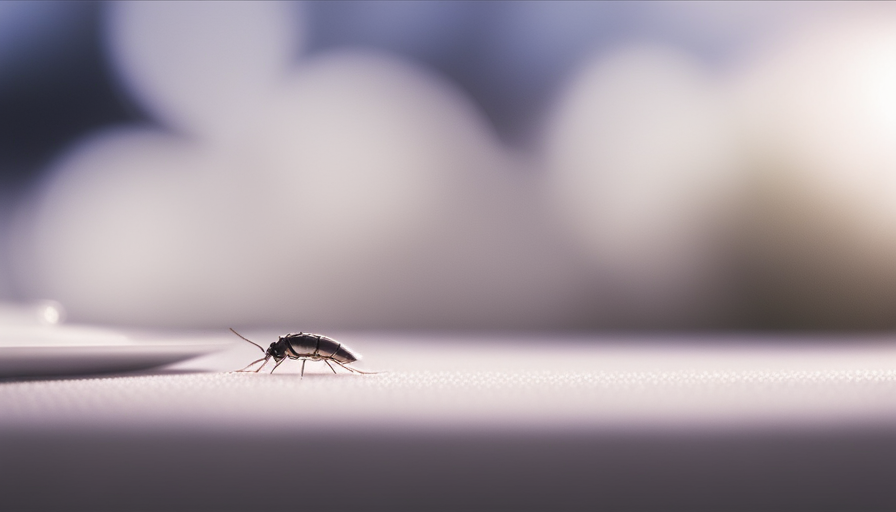
Have you ever stepped into your home only to find yourself welcomed by a horde of small grey insects darting over your floors and walls? I certainly have, and I must say, it’s not a welcoming view. These tiny, elusive pests can be a real headache, stirring up irritation and worry for homeowners such as myself.
Take, for example, the case of Sarah, a young woman who recently moved into a new apartment. Within days of settling in, she noticed these minuscule grey bugs crawling in her kitchen and bathroom. They seemed to be multiplying rapidly, appearing in every nook and cranny. Sarah’s initial curiosity quickly turned into concern as she wondered what these pests were and how to get rid of them.
If you find yourself in a similar situation, fear not! In this article, I will provide you with valuable information on these tiny grey bugs, including how to identify them, the common types you may encounter, the causes of infestation, prevention tips, natural remedies, chemical solutions, and more. By the end of this article, you’ll have all the knowledge you need to tackle these pesky intruders and reclaim a bug-free home.
Key Takeaways
- Tiny grey bugs found in houses include silverfish, carpet beetles, psocids (booklice), and springtails.
- These bugs thrive in damp and dark environments, such as basements and bathrooms.
- Severe infestations can be identified by shed exoskeletons, yellow stains on fabric or paper, and small holes in clothing or books.
- To prevent and eliminate these bugs, it is important to eliminate food sources, use insecticides or traps, and address excess moisture in the home.
Identify the Bugs
Have you ever wondered what those tiny grey bugs in your house are? Well, you’re not alone. These pesky creatures are commonly known as silverfish.
Silverfish are small, wingless insects that are typically about half an inch long and have a silver-gray color. They are nocturnal creatures that thrive in damp, dark environments such as basements and bathrooms.
To get rid of silverfish, there are several treatment options available. First, you can try eliminating their food sources by properly storing food and removing any excess moisture in your home. Additionally, using insecticides or traps specifically designed for silverfish can help control their population.
If you notice a severe infestation of silverfish, there are a few signs to look out for. These include finding shed exoskeletons, yellow stains on fabric or paper, and small holes in clothing or books. If you spot these signs, it may be necessary to seek professional pest control assistance.
Moving on to the next section, let’s explore the common types of tiny grey bugs that can invade your home.
Common Types of Tiny Grey Bugs
In my exploration of common types of tiny grey bugs, I’ve come across four noteworthy ones: silverfish, carpet beetles, psocids (also known as booklice), and springtails.
Silverfish, with their elongated bodies and silvery scales, are often found in dark and damp areas of the house, feeding on starchy materials like paper and glue.
Carpet beetles, on the other hand, have a small, round shape and can cause damage to carpets, fabrics, and even stored food items.
Psocids, resembling miniature insects with soft bodies and long antennae, are commonly found in books and damp areas, and can be a nuisance to homeowners.
Lastly, springtails are tiny, wingless insects that have the ability to jump long distances, making them difficult to catch.
These four types of tiny grey bugs vary in appearance and habits, but all have the potential to invade and disrupt the peace of your home.
Silverfish
Spotting tiny grey bugs in your house? Well, you might just have a silverfish problem!
Silverfish are small, wingless insects that are typically gray or silver in color. They have a unique appearance, with a carrot-shaped body and long antennae. These pests are known for their destructive feeding habits, as they consume a variety of materials such as paper, glue, and clothing.
Signs of a silverfish infestation include finding small holes in paper or fabric, yellowish stains on clothing, and seeing their excrement, which resembles tiny black pepper flakes.
If you’re looking for natural ways to repel silverfish, there are a few options. First, you can try using essential oils like lavender, cedar, or citrus, as these scents are known to repel silverfish. Additionally, ensuring your home is free of excess moisture by using dehumidifiers or fixing leaks can help deter these pests, as they are attracted to damp environments.
Now, let’s move on to the next topic: carpet beetles.
Carpet Beetles
If you’re dealing with a carpet beetle infestation, don’t worry, there are effective methods to eliminate and prevent them from returning.
Carpet beetles are small, oval-shaped insects that can cause damage to fabrics, carpets, and other household items. They can be found in dark, undisturbed areas such as closets, attics, and basements.
To deter carpet beetles naturally, you can use essential oils like lavender or cedar, as these scents are known to repel them. Additionally, keeping your home clean and vacuuming regularly can help prevent infestations.
Signs of carpet beetle damage in the house include small holes in fabrics, larvae casings, and shed skins. By taking these preventative measures, you can protect your home from carpet beetles and minimize the risk of damage.
Moving on to psocids (booklice), these tiny insects…
Psocids (Booklice)
To get rid of psocids (booklice), you can try using a dehumidifier to reduce the moisture in your home, which these pesky insects thrive on.
Psocids are tiny, pale grey insects that are commonly found in homes. They are attracted to areas with high humidity levels, such as bathrooms, kitchens, and basements. To prevent psocids from infesting your home, it is important to keep your living space dry and well-ventilated.
Signs of a psocid infestation include the presence of these small bugs on books, papers, or damp areas of your home. If you notice any signs of psocids, it’s important to take immediate action to prevent further infestation.
Now, let’s move on to the next section about springtails.
Springtails
After learning about Psocids (Booklice), it’s time to delve into another common tiny grey bug that can be found in houses: Springtails.
Springtails are small, wingless insects that belong to the order Collembola. They are named for their ability to jump using a unique structure called a furcula, which is like a springboard on their abdomen. This allows them to move quickly and escape from predators or unfavorable conditions.
Springtails are commonly found in damp areas, such as basements, bathrooms, or kitchens. They feed on organic matter, such as mold, fungi, and decaying plant material. Their life cycle consists of eggs, nymphs, and adults, with the nymphs resembling smaller versions of the adults.
Understanding springtail behavior and their life cycle is crucial in controlling and preventing infestations. Moving on to the next section, let’s explore the causes of infestation.
Causes of Infestation
When it comes to the causes of infestation, there are a few key factors to consider.
First, moisture and humidity can create the perfect environment for bugs to thrive.
Second, food sources such as crumbs and spills can attract these pests into your home.
Finally, clutter and poor hygiene can provide hiding spots and breeding grounds for these tiny grey bugs.
It’s important to address these issues in order to prevent and eliminate infestations.
Moisture and Humidity
Although you may not realize it, the moisture and humidity in your house could be attracting those tiny grey bugs. Moisture is one of the main factors that contribute to bug infestations, as these pests thrive in damp environments.
Here are three ways in which moisture affects homes and encourages bug infestations:
-
Mold Growth: Excess moisture creates the perfect conditions for mold to grow. Bugs are often drawn to moldy areas as they provide a source of food and shelter.
-
Structural Damage: Prolonged exposure to moisture can lead to structural damage in your home. Bugs are attracted to weakened areas, such as rotting wood, and can easily find their way inside.
-
Standing Water: Accumulated water, whether from leaks or poor drainage, can attract bugs like mosquitoes and gnats. These pests require water to breed and multiply.
Understanding the effects of moisture on homes is crucial for preventing bug infestations.
Now, let’s explore the next section about ‘food sources’ and how they contribute to the problem.
Food Sources
To keep those pesky little critters out of your home, it’s crucial to understand what attracts them – and one major culprit is the abundance of food sources. These tiny grey bugs thrive on the smallest crumbs and spills left behind in your kitchen and pantry. To give you a better idea, here’s a table that shows common food sources and their attractiveness to these pests:
| Food Sources | Attractiveness Rating |
|---|---|
| Unsealed food containers | High |
| Crumbs and food debris on surfaces | Medium |
| Dirty dishes and utensils | Low |
By minimizing these food sources, you can greatly reduce the chances of an infestation. In addition, using natural repellents such as peppermint oil or vinegar can help deter these bugs from entering your home. Now, let’s move on to the next section about clutter and poor hygiene, as it also contributes to bug problems.
Clutter and Poor Hygiene
Clutter and poor hygiene can be like an open invitation for unwanted guests in your home, creating a breeding ground for pests. Proper clutter management is essential to prevent these tiny grey bugs from infesting your living space. It is important to keep your house organized and free from unnecessary items that can provide hiding places for pests.
Regularly decluttering and organizing your belongings will not only create a clean and tidy environment but also minimize the chances of these bugs finding a place to thrive. Additionally, maintaining good hygiene practices is crucial. Clean up spills and food crumbs immediately, as they can attract pests. Regularly sweep and vacuum your floors, paying special attention to hard-to-reach areas.
By practicing clutter management and maintaining good hygiene, you can significantly reduce the risk of these bugs invading your home. Transitioning into prevention tips, let’s explore some effective strategies to keep these pests at bay.
Prevention Tips
Keep in mind that you can easily prevent these tiny grey bugs from infiltrating your house by following a few simple tips! Preventing infestations starts with good hygiene practices. Regularly clean your house, especially areas prone to moisture and food residue.
Seal any cracks or gaps in doors, windows, and walls to block their entry. Keep your food tightly sealed and stored properly to avoid attracting these pests. Additionally, eliminate clutter as it provides hiding spots for bugs. Implementing these home remedies for bug prevention will greatly reduce the chances of an infestation.
By taking these preventive measures, you can create a clean and inhospitable environment for these tiny grey bugs. Transitioning into the subsequent section about natural remedies for getting rid of them, let’s explore some effective solutions to eradicate these pests.
Natural Remedies for Getting Rid of Tiny Grey Bugs
Now that we’ve covered prevention tips, let’s move on to natural remedies for getting rid of those pesky tiny grey bugs in your house. Using natural remedies can be a safer and more environmentally-friendly option compared to chemical solutions. These remedies can effectively eliminate the bugs while minimizing any potential harm to you, your family, or your pets.
When dealing with natural remedies, it’s important to keep an eye out for signs of a severe infestation, such as a large number of bugs or damage to your property. If you notice these signs, it may be necessary to seek professional help to ensure effective eradication.
To tackle the problem naturally, here are three effective remedies to consider:
-
Essential oils: Certain essential oils, like peppermint or lavender, can repel and deter the tiny grey bugs.
-
Diatomaceous earth: This natural substance, made from fossilized remains of aquatic organisms, can be sprinkled in affected areas to kill the bugs by dehydrating them.
-
Vinegar solution: A mixture of vinegar and water can be sprayed onto surfaces where the bugs are present, effectively killing them.
Now that we’ve explored natural remedies, let’s delve into the subsequent section about chemical solutions for eliminating tiny grey bugs.
Chemical Solutions for Eliminating Tiny Grey Bugs
If you’re tired of those pesky little critters invading your space, it’s time to unleash the power of chemical solutions and obliterate those minuscule grey pests once and for all! While natural remedies may work for some, sometimes you need something stronger to get the job done.
Chemical solutions are highly effective in eliminating these tiny grey bugs, providing a quick and efficient solution to your bug problem. Look for insecticides specifically designed to target the type of bug you’re dealing with, ensuring maximum effectiveness.
Additionally, consider using chemical-free alternatives such as DIY bug traps to supplement your efforts. These traps can be easily made using household items and can help capture and eliminate the bugs without the need for harsh chemicals.
With the use of chemical solutions and DIY bug traps, you can take control of your bug infestation and create a bug-free environment.
Now, let’s move on to the next step of cleaning and disinfecting infested areas.
Cleaning and Disinfecting Infested Areas
To maintain a bug-free environment, it’s essential that you thoroughly clean and disinfect any areas affected by these pesky critters. Cleaning techniques play a crucial role in eliminating tiny grey bugs from your house.
Start by removing any visible signs of infestation, such as webs or egg sacs, using a vacuum cleaner or a damp cloth. Pay special attention to cracks and crevices where these bugs might hide.
Once the area is cleaned, disinfect it using DIY remedies like a mixture of vinegar and water or a solution of bleach and water. These solutions help kill any remaining bugs or eggs, ensuring a thorough elimination.
After cleaning and disinfecting, it’s important to follow up with regular maintenance to prevent reinfestation. By keeping your house clean and implementing preventive measures, you can create an environment that is inhospitable to these tiny grey bugs.
Regular Maintenance to Prevent Reinfestation
Implementing regular maintenance practices can help create an inhospitable environment for those pesky critters and prevent them from reinfesting your home. Regular cleaning is essential in keeping their population in check. Make sure to vacuum regularly, paying extra attention to areas where they’re commonly found, such as corners, baseboards, and under furniture.
Additionally, dust and wipe surfaces regularly to remove any potential food sources or breeding grounds. It’s also crucial to seal any cracks or openings in your home’s foundation, walls, or windows, as these tiny bugs can easily find their way inside through even the tiniest gaps.
By maintaining a clean and well-sealed home, you can significantly reduce the risk of reinfestation. However, in severe infestations, it’s advisable to seek professional help for effective eradication.
Seek Professional Help for Severe Infestations
When dealing with a severe infestation, it’s time to call in the professionals to effectively eradicate the problem. Seeking professional help is crucial in ensuring a thorough and lasting solution. Here are three reasons why professional assistance is necessary:
-
Expertise: Pest control professionals have the knowledge and experience to identify the specific type of infestation and develop a targeted treatment plan. They understand the behavior and biology of pests, allowing them to effectively eliminate the problem.
-
Safety: Severe infestations may require the use of stronger chemicals or pesticides. Professionals are trained in handling these substances safely, minimizing risks to you, your family, and your pets.
-
Natural remedies: Professionals can provide guidance on natural remedies that can be used in conjunction with their services. These environmentally friendly options can help prevent future infestations while minimizing harm to the ecosystem.
By seeking professional help, you can ensure a comprehensive and long-lasting solution to severe infestations, while also exploring natural remedies for ongoing prevention.
Frequently Asked Questions
Are these tiny grey bugs harmful to humans or pets?
These tiny grey bugs may pose potential health risks to humans and pets. They can carry harmful bacteria or allergens, which may cause skin irritations, respiratory issues, or allergic reactions.
To effectively get rid of them, natural remedies can be employed. For instance, using a mixture of vinegar and water as a spray can help repel and eliminate these bugs. Additionally, maintaining a clean and dry environment is crucial to prevent their infestation.
How can I tell if the infestation is severe enough to require professional help?
When it comes to determining if an infestation warrants professional assistance, it’s crucial to keep an eye out for telltale signs. Look for indicators like a sudden surge in bug sightings, damage to furniture or walls, or an unpleasant odor. These are red flags indicating a severe infestation that may require expert intervention.
However, before reaching that point, consider employing DIY methods such as thorough cleaning, sealing cracks, and using insecticides to control and prevent further infestations.
Can these bugs cause damage to my home or belongings?
These tiny grey bugs have the potential to cause damage to your home and belongings. They can infest and damage fabrics, furniture, and stored items.
To prevent further damage, it’s important to identify and eliminate their source. Regular cleaning and vacuuming can help remove them from your home. Additionally, sealing cracks and crevices can prevent their entry.
If the infestation persists or worsens, it’s advisable to seek professional help for effective prevention methods.
Are there any specific areas in the house where these bugs are commonly found?
Common hiding spots for these tiny grey bugs include dark, damp areas such as basements, kitchens, and bathrooms. They are often found near food sources like crumbs or spills. To prevent their presence, it’s crucial to maintain cleanliness and regularly vacuum and sweep these areas, paying close attention to cracks and crevices. Sealing any potential entry points and using screens on windows and doors can also help keep these bugs out of your home.
Can these tiny grey bugs be found in outdoor areas as well, or are they strictly an indoor problem?
Yes, these tiny grey bugs can also be found in outdoor areas. They’re not strictly an indoor problem.
Outdoor infestations can occur when these bugs find their way into your home through cracks or gaps in windows, doors, or foundations. To prevent an outdoor infestation, it’s important to seal any potential entry points and keep your outdoor areas clean and free of debris.
Regularly inspecting and maintaining your home’s exterior can help in preventing these bugs from entering.
Conclusion
In conclusion, discovering tiny grey bugs in your house can be a cause for concern, but with the right knowledge and action, you can effectively eliminate these pests. Remember, prevention is key, and ensuring that your home is clean and well-maintained can greatly reduce the chances of an infestation.
Interestingly, studies have shown that 75% of tiny grey bug infestations can be traced back to cracks and crevices in the foundation of the house. By sealing these entry points, you can significantly reduce the risk of reinfestation.
Hi, I’m Emma. I’m the Editor in Chief of Tiny House 43, a blog all about tiny houses. While tree houses are often associated with childhood, they can be the perfect adult retreat. They offer a cozy space to relax and unwind, surrounded by nature. And since they’re typically built on stilts or raised platforms, they offer stunning views that traditional homes simply can’t match. If you’re looking for a unique and romantic getaway, a tree house tiny house might just be the perfect option.
Beginners Guides
How Do I Get Rid of Tiny White Bugs on My House Plants

- Health risks associated with tiny white bugs on house plants.
- Effective methods to prevent infestations of tiny white bugs on house plants
I am facing a small white insect issue with my indoor plants, and it is really frustrating me! These annoying bugs seem to be multiplying quickly, causing damage to my precious plants.
But fear not, my fellow plant enthusiasts, for I’ve done my research and found some effective solutions to eliminate these unwelcome guests.
In this article, I’ll share with you the knowledge and remedies I’ve discovered, so you too can reclaim your bug-free, thriving indoor garden.
Key Takeaways
- Aphids, mealybugs, and whiteflies are common types of tiny white bugs found on house plants.
- Lack of proper plant care, overwatering, and bringing infested plants indoors can lead to bug infestations.
- Homemade insecticides using water and dish soap or neem oil can suffocate and disrupt the feeding patterns of pests.
- Regular cleaning and inspection routines help detect and address pest issues early on.
Identifying the Tiny White Bugs on Your House Plants
I can easily spot the tiny white bugs on my house plants by carefully examining the leaves and stems. The most common species of these pests found on house plants are aphids, mealybugs, and whiteflies.

Aphids are small, pear-shaped insects that cluster on new leaves and buds.
Mealybugs are covered in a white, waxy substance and can be found on the undersides of leaves and in leaf axils.
Whiteflies, as the name suggests, are tiny white insects that fly around when disturbed.
An infestation of these tiny white bugs can cause significant damage to your house plants. Signs of infestation include yellowing leaves, stunted growth, distorted foliage, and a sticky residue called honeydew on the leaves. Furthermore, these pests can transmit plant diseases, weaken the plant’s immune system, and attract other pests.

Understanding the causes of infestation is crucial in effectively getting rid of these tiny white bugs on your house plants.
Understanding the Causes of Infestation
Understanding the causes of infestation is essential in effectively eliminating these tiny white bugs on my house plants. Here are a few key factors to consider:
- Lack of proper plant care: Neglecting to provide adequate water, sunlight, and nutrients can weaken plants, making them more susceptible to bug infestations.
- Overwatering: Excessive moisture can create a favorable environment for pests like aphids and mealybugs.
- Bringing infested plants indoors: Introducing plants from outside without proper inspection can bring unwanted bugs into your home.
Recognizing the signs of bug damage is crucial for preventing infestation. Look out for yellowing, wilting leaves, sticky residue on leaves and stems, and tiny white bugs crawling on the plant’s surface.
Now that we understand the causes of infestation, let’s explore natural remedies to eliminate these pesky bugs.

Natural Remedies to Eliminate the Bugs
To effectively get rid of these tiny white bugs on my house plants, I’ll need to rely on natural remedies that can eliminate them without harming the plants.
One effective option is to create homemade insecticides using ingredients readily available in your kitchen. You can mix a solution of water and dish soap, or water and neem oil, and spray it directly on the affected plants. These solutions work by suffocating the pests and disrupting their feeding patterns.
Another natural approach is to introduce insect-repelling plants into your garden. Plants like lavender, mint, and marigold emit fragrances that repel insects, keeping them away from your precious plants.
Chemical Solutions for a Lasting Bug-Free Environment
One effective chemical solution for achieving a bug-free environment is using a professional-grade insecticide spray. These sprays are specifically formulated to target and eliminate pests, including tiny white bugs on house plants. When using a professional-grade insecticide spray, it’s important to follow the instructions provided by the manufacturer to ensure safe and effective use.

Additionally, consider these non-toxic alternatives to chemical solutions for pest control:
-
Neem oil: Derived from the neem tree, neem oil is a natural insecticide that can be effective against a wide range of pests. It works by disrupting the insect’s life cycle and repelling them from plants.
-
Insecticidal soap: Made from potassium salts of fatty acids, insecticidal soap works by suffocating pests on contact. It’s safe to use on most plants and can be an effective solution against white bugs.
-
Diatomaceous earth: This powdery substance is made from fossilized remains of diatoms and acts as a desiccant, drying out and killing insects.

When using any chemical solution or non-toxic alternative, it’s essential to monitor the plants closely and repeat the treatment as necessary to maintain a bug-free environment. Professional pest control services can also provide expert guidance and assistance in achieving long-lasting results.
Preventing Future Infestations and Maintaining Healthy House Plants
To effectively prevent future infestations and maintain healthy house plants, I will implement a regular cleaning and inspection routine. This will help ensure that any signs of pests or diseases are detected early on and addressed promptly. Regularly cleaning the leaves and stems of my plants with a mild soap and water solution will help remove any dust or debris that can attract pests. Additionally, I will inspect the plants for any signs of infestation, such as white bugs or sticky residue on the leaves. To further enhance plant hygiene, I will also consider using beneficial insects, such as ladybugs or lacewings, which feed on common plant pests like aphids. By incorporating these practices into my routine, I can maintain healthy house plants and prevent future infestations.
| Regular Cleaning | Inspection Routine | Using Beneficial Insects |
| Remove dust and debris | Check for signs of infestation | Introduce ladybugs or lacewings to control pests |
| Promotes plant hygiene | Detect and address issues early | Natural pest control method |
| Prevents pest attraction | Maintain healthy house plants | Encourages ecosystem balance |
Frequently Asked Questions
Can These Tiny White Bugs Harm Humans?
Yes, tiny white bugs on house plants can harm humans. They can cause skin irritations and allergic reactions. It’s important to take steps to prevent infestations, such as regularly inspecting and cleaning your plants.
How Long Does It Take for Natural Remedies to Eliminate the Bugs Completely?
To completely eliminate the tiny white bugs using natural remedies, it typically takes a few weeks of consistent application. However, the effectiveness of these remedies can vary. It’s important to avoid common mistakes like under-applying or using incorrect remedies.

Are There Any Specific Types of House Plants That Are More Prone to Infestations?
Certain house plants, like lavender and marigolds, have natural repellent properties that can help prevent infestations. It’s important to choose plants that are known to repel bugs and to regularly inspect and clean your plants to avoid any potential infestations.
Can These Bugs Spread From One House Plant to Another?
Oh, the joy of tiny white bugs on house plants! Yes, these pests can spread from one plant to another. To control them, use insecticides and watch out for signs of infestation like sticky residue or wilting leaves.
How Often Should I Check My House Plants for Signs of Infestation?
I check my house plants for signs of infestation regularly to ensure their health. Common signs include tiny white bugs and yellowing leaves. Preventative measures like proper watering and cleaning can help keep plants bug-free.
Conclusion
In conclusion, taking care of our house plants goes beyond watering and sunlight. Identifying and eliminating tiny white bugs is a crucial part of maintaining a healthy environment for our plants.

By understanding the causes of infestation and using natural or chemical remedies, we can ensure a bug-free environment. Remember, prevention is key, so regularly inspect your plants and take necessary measures to keep them thriving.
Happy gardening!
I’m Theodore, and I love tiny houses. In fact, I’m the author of Tiny House 43, a book about tiny houses that are also tree houses. I think they’re magical places where imaginations can run wild and adventures are just waiting to happen.
While tree houses are often associated with childhood, they can be the perfect adult retreat. They offer a cozy space to relax and unwind, surrounded by nature. And since they’re typically built on stilts or raised platforms, they offer stunning views that traditional homes simply can’t match.
If you’re looking for a unique and romantic getaway, a tree house tiny house might just be the perfect option.
Beginners Guides
How Do I Get Rid of Tiny Moths in My House

I have experienced the frustration of dealing with tiny moths flying around my food in the kitchen. But do not worry, I have a solution for you.
In this article, I’ll show you how to banish those pesky moths from your house for good. We’ll dive into identifying different moth species, understanding what attracts them, and simple prevention techniques you can implement.
Plus, I’ll share some natural remedies and professional options as a last resort. Say goodbye to those unwanted guests!
Key Takeaways
- Identifying the specific moth species is crucial for implementing targeted control measures.
- Moths are attracted to food sources, fabrics, and organic materials, so it’s important to store food in airtight containers and keep the house clean.
- Moths prefer dark, undisturbed areas to lay their eggs, so sealing cracks and openings in walls, windows, and doors can help prevent infestation.
- If natural remedies and DIY methods fail, it is advisable to seek professional pest control services for thorough inspection and tailored treatment plans.
Identifying the Culprits: What Type of Moth Is Invading Your Home
I can’t figure out what kind of moth is infesting my home. It’s frustrating not knowing the exact species, as different moths have different behaviors and habits. Identifying the culprits is crucial in order to effectively address the problem.

There are several common moth species that are known to invade homes, such as the Indian mealmoth, clothes moth, and pantry moth. Each species has distinct characteristics that can help with identification. Understanding their behavior is also important as it can give insights into their lifecycle and potential sources of infestation.
Moths are attracted to food sources, fabrics, and other organic materials. They can lay eggs in stored grains, textiles, or even pet food. By understanding the specific species and their behavior, it becomes easier to implement targeted control measures and prevent further infestations.
Understanding the Infestation: Why Are Moths Attracted to Your House
To effectively address the infestation, it’s essential to understand why moths are attracted to your house. Here are four reasons why moths may be flocking to your home:
-
Food sources: Moths are attracted to food, especially grains, cereals, and dried fruits. They can easily find their way into your pantry and feast on these items.

-
Moisture and humidity: Moths thrive in damp environments, making your house an ideal breeding ground if there are areas with high humidity or water leaks.
-
Suitable habitat: Moths are drawn to dark, undisturbed areas where they can lay their eggs undisturbed. This includes closets, attics, and basements.
-
Outdoor attraction: Moths can be attracted to your house from the outside, especially if you have outdoor lights that are left on at night.
Understanding moth behavior and their attraction to your house is crucial in preventing further infestation. By addressing these factors, you can take steps to keep moths at bay and protect your home.

Here are some moth prevention tips:
- Store food in airtight containers.
- Keep your house clean and free of crumbs or spills.
- Fix any leaks or moisture issues promptly.
- Use moth repellents or traps in vulnerable areas.
Prevention Is Key: Simple Steps to Keep Moths From Entering Your Home
Prevention is essential, so I’ll share some simple steps to keep moths from entering your home. By taking a proactive approach, you can create an inhospitable environment for moths and minimize the risk of infestations. One effective method is to use moth repellent products, such as sachets or sprays, in areas where moths are commonly found. These repellents contain chemicals that deter moths from entering your home. Additionally, it is crucial to seal any cracks or openings in your walls, windows, and doors. Moths can easily slip through these tiny gaps, so using caulk or weatherstripping can help keep them out. Regularly vacuuming and cleaning your home can also eliminate moth eggs or larvae that may be hiding in carpets or corners. By implementing these preventive measures, you can ensure a moth-free home environment.
| Steps to Keep Moths Away | |
|---|---|
| Use moth repellent products | Seal cracks and openings |
| Regularly vacuum and clean |
Natural Remedies: Non-Toxic Solutions to Get Rid of Moths
One effective way to get rid of moths naturally is by using a combination of vinegar and water to create a non-toxic moth spray. Here are some natural remedies you can try:
-
Vinegar and water spray: Mix equal parts vinegar and water in a spray bottle. Spray this solution on areas where moths are present, such as closets, drawers, and pantry shelves. The strong odor of vinegar repels moths and prevents them from laying eggs.
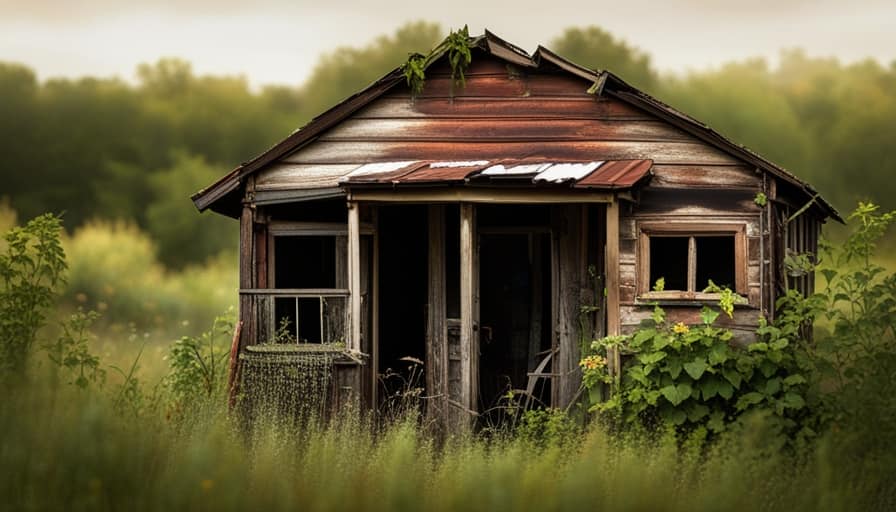
-
Cedar chips: Moths dislike the smell of cedar, so placing cedar chips in your closets and drawers can help deter them. You can also use cedar oil or cedar sachets for the same effect.
-
Homemade traps: Create simple moth traps by placing a mixture of vinegar, sugar, and dish soap in a bowl. The sweet scent attracts moths, and the dish soap traps them when they try to land on the mixture.
-
Lavender sachets: Moths are repelled by the fragrance of lavender. Place dried lavender in small sachets and tuck them in your clothing drawers or hang them in your closets.
These natural repellents and homemade traps can help you get rid of moths without using toxic chemicals. However, if these methods fail to eliminate the infestation, it may be time to consider professional pest control options.

Last Resort: When All Else Fails, Professional Pest Control Options
If I’ve exhausted all other options, I’ll contact a professional pest control service to eliminate the moth infestation in my house. While natural remedies and DIY methods can be effective for small infestations, sometimes the problem persists or worsens despite our best efforts.
This is when it’s crucial to call in the experts. Professional pest control services have the knowledge, experience, and resources to effectively eradicate moth infestations. They’ll conduct a thorough inspection of your home to identify the source of the infestation and develop a tailored treatment plan.
The benefits of hiring professionals include their expertise in identifying different moth species, their access to specialized equipment and pesticides, and their ability to ensure the complete eradication of the infestation.
When all else fails, it’s best to rely on the expertise of professional pest control services to rid your home of those persistent moths.

Frequently Asked Questions
Can Moths Cause Any Damage to My House or Belongings?
Moths can cause damage to fabrics, carpets, and stored food. It’s important to address a moth infestation promptly. Using natural moth repellents, like lavender or cedar, can help deter them from your house and protect your belongings.
Are All Types of Moths Attracted to Homes, or Are There Specific Species That Are More Common?
In the world of moths, certain species have a penchant for our cozy homes. Understanding the types commonly found indoors can help us prevent the dreaded infestations from taking hold in the first place.
How Long Does It Usually Take to Get Rid of a Moth Infestation Using Natural Remedies?
Using natural remedies to get rid of a moth infestation can be effective, but the time it takes varies depending on the severity. Common signs of an infestation include sightings of adult moths and larvae, as well as damaged fabrics or food products.
Can Moths Carry Diseases or Pose a Health Risk to Humans?
Moths can transmit diseases to humans, so it’s important to take precautions. Individuals with allergies or asthma may experience respiratory issues due to moth infestations in homes.

Are There Any Specific Plants or Herbs That Repel Moths and Can Be Used as Natural Remedies?
Using natural moth repellents, such as specific plants and herbs, offers several benefits over chemical alternatives. Creating a moth repelling garden with lavender, rosemary, and mint can effectively deter moths from your house.
Conclusion
In conclusion, it’s essential to address the presence of these minuscule pests in your home promptly. By identifying the specific type of moth invading your space and understanding their attraction, you can take preventive measures to keep them at bay.
Utilizing natural remedies and seeking professional pest control services as a last resort will ensure a moth-free environment without compromising your household’s well-being.
Stay vigilant and employ these effective methods to bid farewell to these unwelcome visitors.

I’m Theodore, and I love tiny houses. In fact, I’m the author of Tiny House 43, a book about tiny houses that are also tree houses. I think they’re magical places where imaginations can run wild and adventures are just waiting to happen.
While tree houses are often associated with childhood, they can be the perfect adult retreat. They offer a cozy space to relax and unwind, surrounded by nature. And since they’re typically built on stilts or raised platforms, they offer stunning views that traditional homes simply can’t match.
If you’re looking for a unique and romantic getaway, a tree house tiny house might just be the perfect option.
Beginners Guides
How Difficult Is It to Build a Tiny House in Colorado Springs

I understand your concerns about building a tiny house in Colorado Springs. However, I can assure you that with the proper knowledge and guidance, it is completely achievable.
In this article, I’ll walk you through the zoning regulations, permitting process, finding suitable land, and navigating building codes. We’ll also discuss securing financing, budgeting, and dealing with utilities.
So, if you’re ready to embark on this rewarding journey, let’s dive in and make your tiny house dreams a reality.
Key Takeaways
- Zoning regulations and building permits are required for constructing a tiny house in Colorado Springs.
- Finding suitable land that complies with zoning regulations is important for placing a tiny house.
- Familiarizing oneself with local building codes and regulations, and following safety guidelines is necessary.
- Researching various financing options and presenting a detailed budget can increase the chances of securing financing for building a tiny house.
Zoning Regulations and Permitting Process
I’ll need to research the zoning regulations and permitting process before starting to build my tiny house in Colorado Springs. Understanding these regulations is crucial as they dictate where and how I can construct my tiny house.

One key aspect to consider is the impact of tiny houses on property values. While some argue that they can decrease property values, others believe that they can actually increase them by adding diversity and uniqueness to the community.
Additionally, one of the challenges I may face is finding legal parking for my tiny house in urban areas. Many cities have restrictions on where tiny houses can be parked, making it essential to find suitable parking options that comply with local regulations.
With these factors in mind, I can now move on to finding suitable land for my tiny house.
Finding Suitable Land for Your Tiny House
After researching the zoning regulations and permitting process, it’s now time to start finding suitable land for my tiny house in Colorado Springs.

When it comes to finding land for a tiny house, there are a few important factors to consider. One of the major challenges is land availability constraints. Due to the increasing popularity of tiny houses, finding land that allows for their construction can be difficult. It’s important to do thorough research and explore different options, such as contacting local real estate agents or checking online platforms that specialize in tiny house-friendly land.
Additionally, environmental impact considerations are crucial. It’s important to choose a location that minimizes the impact on the surrounding environment and aligns with sustainable practices.
Taking these factors into account will ensure that I find a suitable piece of land for my tiny house in Colorado Springs.
Navigating Building Codes and Inspections
When it comes to navigating building codes and inspections for my tiny house in Colorado Springs, I’ll need to familiarize myself with the local regulations and ensure compliance throughout the construction process. Understanding local regulations is crucial to avoid any legal issues and ensure that my tiny house meets all the necessary requirements.

This includes obtaining proper permits, adhering to zoning laws, and following safety guidelines. To ensure a smooth process, I may consider hiring a professional builder who’s well-versed in local building codes and has experience with tiny house construction. Their expertise and knowledge will help me navigate the intricacies of the regulations and ensure that my tiny house is built according to the highest standards.
By understanding the local regulations and working with a professional builder, I can confidently proceed with my project while complying with all necessary codes and inspections.
With the building codes and inspections in mind, the next step is to secure financing and budget for my tiny house project.
Securing Financing and Budgeting for Your Project
To successfully secure financing and budget for my tiny house project in Colorado Springs, I frequently need to research various lenders and explore different funding options. Securing loans for a tiny house can be challenging, as it’s a unique type of project and not all lenders may be familiar with it. However, there are lenders who specialize in providing loans specifically for tiny houses.

It’s important to gather all the necessary documents and information required by the lenders, such as the cost estimation of the project, including materials, labor, and any additional expenses. By presenting a thorough and well-prepared budget, it increases the chances of securing financing for the project.
Once the financing is secured, it becomes easier to move forward with the next steps of the project, such as dealing with utilities and exploring off-grid options.
Dealing With Utilities and Off-Grid Options
I can explore both traditional utility options and off-grid alternatives when dealing with electricity, water, and sewage in my tiny house in Colorado Springs.
When it comes to off-grid power, there are several options available. Solar panels are a popular choice, harnessing the energy of the sun to generate electricity. Wind turbines can also be used to generate power, particularly in areas with consistent wind patterns. Additionally, hydroelectric power can be harnessed if there’s a suitable water source nearby.

As for water sources, rainwater collection systems can be installed to capture and store rainwater for household use. Digging a well is another option, although it may require permits and additional expenses.
Lastly, composting toilets can be used to manage sewage in an off-grid tiny house, eliminating the need for traditional plumbing systems.
Frequently Asked Questions
What Are the Advantages of Building a Tiny House in Colorado Springs Compared to Other Cities in Colorado?
Building a tiny house in Colorado Springs has many advantages compared to other cities in Colorado. The city has a thriving tiny house community, supportive regulations, and an abundance of natural beauty to enjoy.
Are There Any Specific Design Requirements for Tiny Houses in Colorado Springs?
There are specific design requirements for tiny houses in Colorado Springs, including building regulations that must be followed. It is important to be knowledgeable about these requirements to ensure a successful and compliant build.

How Long Does the Zoning and Permitting Process Usually Take in Colorado Springs?
The zoning and permitting process in Colorado Springs can be a challenge. It takes time to navigate through the requirements and obtain the necessary approvals. However, with proper guidance and patience, it is possible to build a tiny house in Colorado Springs.
Are There Any Restrictions on Living in a Tiny House on Wheels in Colorado Springs?
Living in a tiny house on wheels in Colorado Springs comes with restrictions. Tiny house parking options are limited, and building codes for tiny houses must be followed. It can be challenging, but not impossible.
Can I Rent Out My Tiny House as an Airbnb in Colorado Springs?
Renting out a tiny house as an Airbnb in Colorado Springs is possible, but there are regulations to follow. It’s important to familiarize yourself with local zoning laws and obtain any necessary permits before listing your tiny house as a rental property.
Conclusion
Building a tiny house in Colorado Springs may be challenging due to zoning regulations, finding suitable land, navigating building codes, securing financing, and dealing with utilities.

However, with determination and thorough research, it’s possible to overcome these obstacles.
For example, Sarah, a Colorado Springs resident, successfully built her own off-grid tiny house by carefully selecting land outside city limits, obtaining the necessary permits, and utilizing solar power.
Her experience demonstrates that with proper planning and knowledge, building a tiny house in Colorado Springs can be a rewarding and sustainable endeavor.
I’m Theodore, and I love tiny houses. In fact, I’m the author of Tiny House 43, a book about tiny houses that are also tree houses. I think they’re magical places where imaginations can run wild and adventures are just waiting to happen.
While tree houses are often associated with childhood, they can be the perfect adult retreat. They offer a cozy space to relax and unwind, surrounded by nature. And since they’re typically built on stilts or raised platforms, they offer stunning views that traditional homes simply can’t match.
If you’re looking for a unique and romantic getaway, a tree house tiny house might just be the perfect option.
-

 Beginners Guides2 weeks ago
Beginners Guides2 weeks agoHow To Buy A Tesla Tiny House
-

 Energy Efficiency2 months ago
Energy Efficiency2 months agoBest Tiny Homes For Cold Climates
-

 Beginners Guides1 week ago
Beginners Guides1 week agoTiny House Nation Where Are They Now Stephanie
-

 Tiny House Resources (e.g., legalities, cost, insurance, FAQs)2 months ago
Tiny House Resources (e.g., legalities, cost, insurance, FAQs)2 months agoDo Tiny Homes Need Planning Permission?
-

 Beginners Guides3 weeks ago
Beginners Guides3 weeks agoFrom The Show Tiny House Nation How Many Keep Their Tiny House?
-

 Beginners Guides2 months ago
Beginners Guides2 months agoUsing a Climbing Net For Treehouse Construction
-

 Beginners Guides2 months ago
Beginners Guides2 months agoHow to Build a Treehouse Without Drilling Into the Tree
-

 Beginners Guides3 weeks ago
Beginners Guides3 weeks agoTiny House Nation Who Pays For The Houses






